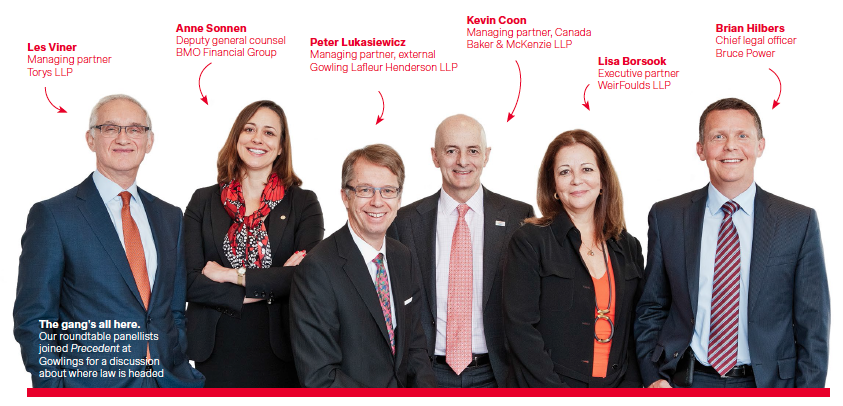The players


Meet your moderator
Our panellists had the answers, but one man had all the questions: Daniel Fish, Precedent’s discerning news editor, led the roundtable discussion. Read his editor’s notes below as he guides us through an idea-rich dialogue about how to make law’s future a bright one.
The future of national firms
Daniel: Do you think a young lawyer starting out now could build a national firm in his or her lifetime?
Peter: In the sense of a full-service model, I think that’s unlikely. One of the issues facing our profession is that there are too many lawyers chasing too little work — particularly in the large firms.
Anne: I think it would have to be a law firm based on a different business model. It might have a relationship with an offshore company — who’s going to do due diligence and e-discovery — and a bunch of contract or salaried lawyers. [Ed. note: A few innovative start-ups have already given these strategies a try, with some success. But will they replace big firms altogether?]
Daniel: Since the 2008 recession, firms have had to survive a tight economy with fewer deals. How will that continue to affect the legal industry?

Les Viner, managing partner, Torys LLP
Les: In the law profession, the definition of quality has changed to include cost. If quality means outstanding work and service, it has to be at the right price as well.
Anne: At BMO, we tell our firms all the time: ‘We have a productivity initiative to reduce legal spend and we will meet it.’ And we already are.
Kevin: We, on the firm side, need to drive down costs because clients want to increase efficiency and drive down costs as well. Take document review: should that be done by a third-year lawyer sitting in Toronto at $250 an hour when it could be done by an outsourcing service out of India, Manila or Ireland at $50 an hour? [Ed. note: While Baker & McKenzie sends legal work overseas, Torys will soon insource work to an office in Halifax. Find out the pros and cons of each approach.]
Peter: Since 2008, the large law firms have all gotten smaller as we’ve embraced the need to get leaner and be more efficient. For the first time, we are seriously embracing technology that can improve how we deliver services. And one of the outcomes of that is we don’t need as many people as we thought we needed. [Ed note: In fact, Gowlings uses a software program called GhostDraft that helps lawyers write legal agreements faster.]
Diversity in the profession
Daniel: Lisa, as an executive partner — and one of the first female managing partners at a mid-size Toronto law firm — what were things like for women when you started to practice law?
Lisa: I worked in a hospitable environment. But on the client side, perhaps, they were less open to the idea of being counselled by a woman than by the men I worked with.
I remember a closing I did in 1986. I had prepared all the documents and we met over the course of five days to hammer out the details. I played an integral role on the legal team. But at the same time, I was still expected to make photocopies and get everybody coffee.
Daniel: And now?

Lisa Borsook, executive partner, WeirFoulds LLP
Lisa: Things have changed dramatically, but we have so far to go. I mean, the statistics on the number of women who leave private practice is a little daunting. [Ed. note: In Ontario, women make up only 35 percent of lawyers in private practice and 20 percent of partners.]
Daniel: Are you optimistic that the percentage of female partners will rise in the future?
Lisa: I am optimistic. I will say, though: the demands on partners, both women and men, are extraordinary. I’m concerned about how the profession will tackle those challenges. People don’t want to work 24/7 for 30 years. I can see why, if I was a young person, the prospect of spending 10 years working a lot of hours to make partner might not be as desirable as other professions.
Daniel: So what can firms do to make a career in law more attractive?
Lisa: At WeirFoulds, we have substantive conversations about these issues. I have open conversations with my female associates about how to juggle the demands they’ll have in their career and in their home life.
Daniel: And what will encourage firms to increase the number of women in leading roles at law firms?
Anne: In Canada, we are the first financial institution to ask our firms to release diversity statistics to us — and many of them have agreed to, so kudos to our firms. It’s better for our shareholders — we make more money and better decisions when we have diverse teams. So we expect diversity from our firms. [Ed. note: BMO demands five key statistics from firms. Find out what they are.]
Kevin: What Anne’s indicated is what we’re all seeing: companies around the globe — the United States in particular — want to work with firms that reflect the way they look in terms of diversity. This is taking off.

Brian Hilbers, chief legal officer, Bruce Power
Brian: Diversity is very important at Bruce Power. We have diversity targets, which we’ve actually exceeded. And we’ve gone to our major law firms and explained where we are on our diversity targets and what we’re looking for.
Anne: Here’s another thing we’ve done: we select our relationship managers for a lot of our firms. This is our go-to person if there’s an issue. Firms used to say, ‘I’m giving you X.’ Now, we say, ‘No thanks. We want to interview two or three people and here’s what we want them to look like.’ [Ed. note: Bank of Montreal asks a lot of its firms. But the bank gives a lot, too — it published its own diversity numbers (and targets) to the public. For instance, we know that 30 percent of the bank’s executives are women and BMO wants to increase that to 40 percent by 2016.]
Daniel: In that case, firms need female associates to advance at the pace of their male counterparts. Otherwise clients won’t have any women to choose from. How can firms accomplish that?
Lisa: Well, we no longer judge lawyers against colleagues in their same year of call. We now have a totally different system. We create benchmarks of accomplishment in each practice area. As long as they are continuing to move forward, length doesn’t matter. As long as they are progressing, we consider them to be a capable colleague.
Daniel: So even if associates fall behind the rest of their year of call — say, to have a child, or to take care of a sick parent — they’re still advancing, rather than being forced out of the firm.
Lisa: Absolutely.
Les: You’re able to match people’s aspirations at different phases of their life to suitable roles in the firm. And, hopefully, you end up with less attrition. Which is good for clients: they like seeing people they like for long periods of time. They don’t like turnover.
Heenan Blaikie and the future of partnerships
Daniel: Let’s talk about Heenan Blaikie. When that firm collapsed earlier this year, did that make you think more critically about your own businesses?

Peter Lukasiewicz, managing partner, external, Gowling Lafleur Henderson LLP
Peter: Candidly, I think succession was an issue at Heenan. We’ve all learned lessons from Heenan, and the lesson for me is the importance of leadership and building a culture within the firm that defines the direction of the business. It’s part of the larger change in law firms: we’re running businesses that are as large as companies on the TSX. And we are learning how to run those large businesses. [Ed. note: Two years before the meltdown, founding partner Roy Heenan stepped down as chairman and didn’t appoint a replacement, leaving the managing partners in Toronto and Montreal to jockey for authority.]
Anne: I don’t know any of the details about Heenan, but we continue to hear more rumbling of this sort of thing at other firms and that, if Canadian firms do not continue to innovate, there won’t be many left: they’ll be gobbled up by the larger international firms. [Ed. note: And innovation can come in many forms — even just learning how to use existing technology better.]
Daniel: So, what will partnerships look like in the future?
Les: Many lawyers live in a very binary world: are you an associate or are you a partner? That’s very unsophisticated. We’ve abandoned the so-called up-or-out model, where after so many years you’re a partner, or not a partner and you leave. Now, we want to create customized roles.
Peter: As much as it pains me to say, the accounting firms figured this out a long time ago. If you go into most accounting firms, they’ve got half a dozen levels of employees with a number of different forks in the road. We’ve got to be just as creative when managing employees.

Kevin Coon, managing partner, Canada, Baker & McKenzie LLP
Kevin: Since the dissolution of Heenan Blaikie, many lawyers seem nervous about becoming equity partners. Some job applicants — not from Heenan, but other firms — have said, ‘I don’t have any problem not being a partner, because I don’t want to put any equity at risk.’ Before Heenan fell, I’d never heard that issue expressed.
Daniel: As law firms try to be more creative, does that change the kind of students and young lawyers you want to hire?
Kevin: I’m really conflicted. The Law Society tells us we have an obligation to participate in the on-campus interview process — a significant commitment for firms. But if we pulled out of that process, we wouldn’t have a problem finding top legal talent. We get applicants from around the world. And, quite frankly, many of those students are the ones that we’re attracted to. They have a global outlook. Maybe they’ve spent a summer at a bank in Zurich. Soon, I think some of the historical big firms are going to pull out of the system.
Les: We need a much more sophisticated talent- management paradigm. And the starting point is: you can’t have 17-minute interviews to hire your talent. That’s a total crapshoot.
The death of the billable hour
Daniel: As clients continue to demand lower costs, will firms start to move away from the billable hour?
Anne: Yes! Our goal is to move all of our external spend off the billable hour rate. We have whole teams that will not open a file with a firm if it’s on the billable hour.
Les: We are prepared to embrace fixed-fee pricing, but it’s a lot of work. The firm and the client have to invest a lot of time together to get it right. So, to me, the barrier is accepting that there will be mistakes made along the way.

Anne Sonnen, deputy general counsel,
BMO Financial Group
Anne: It is a long and hard journey. We spend hours with folks at the table figuring out how to do it.
Peter: You’re not going to always get it right. But if you have a sufficient number of fixedfee arrangements, there will be some winners and some losers. Overall, it will balance out. And that’s what you’re trying to do: manage the legal spend and deliver predictability. I expect in less than 10 years, it will be the norm. Look, [Peter points out the window at a nearby skyscraper] if you can build that building on a fixed price, why can’t you deliver legal services on a fixed-price basis?
Lisa: I think the genie is out of the bottle here. There’s not much point in debating whether or not the change that’s occurred in the legal industry in the past 15 years is something we can reverse. [Ed. note: On the other hand, perhaps the debate still has some life: at least one lawyer was willing to admit the billable hour will keep breathing in the coming years.]
Daniel: Is there resistance, though?
Kevin: Daniel, there is resistance. But the reaction from Anne is indicative of what all law firms must react to. We’re cognizant of what our clients want: predictability, quality and lower costs. Those of us who don’t respond will be left as dinosaurs.
Brian: What we’ve looked at in certain circumstances is value-based billing, where, if we’re successful, then I’m willing to pay for that success.
Daniel: If you’re charging based on value, you’re almost shifting unpredictability onto the firm.
Brian: Yes, you’re right. But from my perspective we should both sink or we should both swim together.
Illustration by Raymond Biesinger; Photography by Margaret Mulligan


